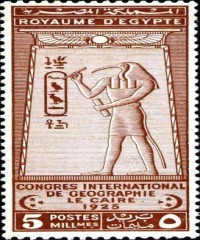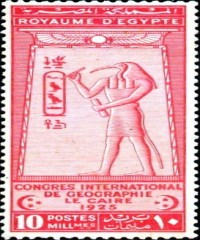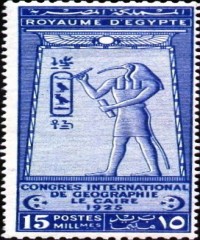Thoth was one of the deities of the Egyptian pantheon In art he was often depicted as a man with the head of an ibis or a baboon animals sacred to him His feminine counterpart was Seshat and his wife was Ma'at
Thoth's chief temple was located in the city of Khmun later called Hermopolis Magna during the Greco-Roman era (in reference to him through the Greeks' interpretation that he was the same as their god Hermes) and ϣⲙⲟⲩⲛⲉⲓⲛ Shmounein in the Coptic rendering Khmun was partially destroyed in 1826 CE In that city he led the Ogdoad pantheon of eight principal deities He also had numerous shrines within the cities of Abydos Hesert Urit Per-Ab Rekhui Ta-ur Sep Hat Pselket Talmsis Antcha-Mutet Bah Amen-heri-ab and Ta-kens
Thoth played many vital and prominent roles in Egyptian mythology such as maintaining the universe and being one of the two deities (the other being Ma'at) who stood on either side of Ra's boat In the later history of ancient Egypt Thoth became heavily associated with the arbitration of godly disputes the arts of magic the system of writing the development of science and the judgment of the dead
Depictions
Thoth has been depicted in many ways depending on the era and on the aspect the artist wished to convey Usually he is depicted in his human form with the head of an ibis In this form he can be represented as the reckoner of times and seasons by a headdress of the lunar disk sitting on top of a crescent moon resting on his head When depicted as a form of Shu or Ankher he was depicted to be wearing the respective god's headdress Sometimes he was also seen in art to be wearing the Atef crown or the United Crowns of Upper and Lower Egypt When not depicted in this common form he sometimes takes the form of the ibis directly
He also appears as a dog-faced baboon or a man with the head of a baboon when he is A'an the god of equilibrium In the form of A'ah-Djehuty he took a more human-looking form These forms are all symbolic and are metaphors for Thoth's attributes. The Egyptians did not believe these gods actually looked like humans with animal heads For example Ma'at is often depicted with an ostrich feather the feather of truth on her head or with a feather for a head
Attributes
Thoth's roles in Egyptian mythology were many He served as a mediating power especially between good and evil making sure neither had a decisive victory over the other He also served as scribe of the gods credited with the invention of writing and alphabets (i.e. hieroglyphs) themselves In the underworld Duat he appeared as an ape A'an, the god of equilibrium who reported when the scales weighing the deceased's heart against the feather representing the principle of Ma'at was exactly even
The ancient Egyptians regarded Thoth as One self-begotten and self-produced He was the master of both physical and moral (i.e. divine) law making proper use of Ma'at He is credited with making the calculations for the establishment of the heavens stars Earth and everything in them Compare this to how his feminine counterpart Ma'at was the force which maintained the Universe He is said to direct the motions of the heavenly bodies Without his words, the Egyptians believed the gods would not exist His power was unlimited in the Underworld and rivalled that of Ra and Osiris
The Egyptians credited him as the author of all works of science religion philosophy and magic The Greeks further declared him the inventor of astronomy astrology the science of numbers mathematics geometry land surveying medicine botany theology civilized government the alphabet reading writing and oratory They further claimed he was the true author of every work of every branch of knowledge human and divine







